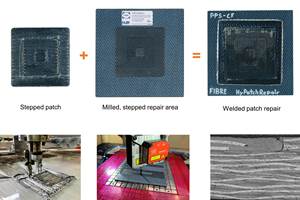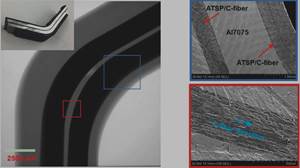Sub-8-minute cycle times on carbon/epoxy prepreg
Globe’s Generation 2 RapidClave system passes another out-of-autoclave milestone.
At the Society of Plastics Engineers’ 2012 Automotive Composite Conference & Exhibition (SPE ACCE, Troy, MI, US), keynote presenters Calvin J. Bamford Jr., chairman/owner of Globe Machine Manufacturing Co. (Tacoma, WA, US) and Gary Lownsdale, then chief technology officer at Plasan Carbon Composites (Wixom, MI, US), described a jointly developed out-of-autoclave (OOA) process. The technology, they said, would reduce process cycle time for carbon fiber/epoxy prepreg laminates from almost 2 hours in an autoclave to a mere 17 minutes.
A few months later, the automotive world learned that Plasan would use that new technology, now dubbed RapidClave, to produce Class A bonded hood and roof panels for the new Corvette Stingray from General Motors Co. (GM, Detroit). Using a new process on a high-visibility nameplate like the Corvette was considered, by itself, innovative and risky. Equally big news, however, were the follow-up reports: GM’s projected production volumes for the parts were an order of magnitude greater than those for any previous CFRP-bodied vehicle. Further, the demolded parts reportedly come out of their tools with such good surfaces that postmold finishing operations aren’t as great a production bottleneck as they often can be. Therefore, part cost is justifiable for a sports car with a price tag of less than US$75,000.
During that 2012 presentation, Bamford and Lownsdale also announced very ambitious plans to halve the cycle time on each subsequent generation of the RapidClave process. Although they were achieving 17-minute cycles, the speakers claimed that they had already modeled sub-10-minute cycles, using conventional resin and prepreg technology. That work paid off in November 2014, when Globe trialed its second-generation RapidClave system and successfully molded unidirectional carbon fiber/epoxy prepreg (6-8 plies, 0°/90° layup) at 8-, 7- and 6-minute cycles (button-to-button). Bamford reports part quality was excellent, and that parts were fully cured and showed less than 2% void content. Plaques produced during the trial were sent out for mechanical testing and, at CW press time, results were expected back by year-end 2014.
Oil to water is the key
Lownsdale, who retired from Plasan in 2014 and now consults for Globe as president of TransTech International (Louden, TN, US), explains that a key difference between the first- and second-generation process technology is the medium for heat transfer. “In the first-generation presses, we used hot oil to heat our work pieces,” he reports. “While that was fast, it wasn’t fast enough. So, for generation two we’re using a combination of water and hot-air impingement to simultaneously heat both sides of the part.”
He notes this change yields faster heat transfer and tighter process control, which, in turn, expands the types of materials that can be processed. “Now we can work with the full range of epoxy resins — even snap-cure systems, which we couldn’t use before because we didn’t have fast-enough heat input or precise enough control over the heat cycle,” he claims. Although trials, to date, have been run only with epoxy to get a meaningful comparison of cycle times and laminate performance between the RapidClave’s first- and second-generations, Globe’s “Gen-2” process reportedly isn’t limited to epoxy.
Like the Gen 1 tooling, Gen 2 molds are single-sided. The part’s B-side is closed off with either a bag or a bladder. Water lines are cut into the tool, which for this trial was produced by Globe in an unnamed metallic material. (Production parts on Gen 1 systems are formed with nickel-shell tools.) Although the Gen 2 system’s superstructure looks no different from the outside and the basic process is said to be the same, the method is different enough that the company already has applied for a new series of patents. To ensure the widest possible application of Gen 2 technology, new RapidClave units reportedly are designed for use with either nitrogen or air, the former favored by the aerospace industry for its thick-section parts, the latter preferred by automotive molders, who fabricate thinner, bonded assemblies.
Based on positive results from the November trial, Bamford expected to run additional trials before year’s end, using cored materials, something that hadn’t been attempted with the Gen 1 RapidClave.
Asked, theoretically, what would be the biggest part that could be molded with a RapidClave system, Bamford laughed and said the development team has just finished that discussion. He believes it will be possible to produce a single part, such as a wingskin, up to 31m long and 5-6m wide in 30-40 minutes — a cycle time much shorter than the 8 hours he says is currently considered fast in the aerospace industry.
Lownsdale claims that, even on that scale, the basic process technology would remain the same. Further, the pressure mechanism would require only a thin column of air, so a large part wouldn’t require as much machine volume to mold parts as one might assume.
RTM, ATL on horizon?
Work on RapidClave technology continues apace. Reportedly, Globe has been evaluating how thermoplastic matrices can be used in the system. “We’ve completed intensive engineering studies to prove the process will work for carbon-reinforced thermoplastics,” Lownsdale reveals. Although he’s tight-lipped about which resin chemistries they’re using, he does say that they are working with several of the “best big resin suppliers” and that processes that variously employ thermoplastic tapes and press-side impregnation of carbon fibers are under investigation. Bamford emphasizes that halving machine cycle time on each new RapidClave generation is still the primary goal and the use of thermoplastics will be critical to that continuing effort. “We believe we need to do this to be competitive for higher production volumes and to compete with alternative processes, like RTM,” he notes. But he also hints that the company has been working in parallel with RapidClave’s Gen-2 development on what might become an “RTM-like” process, although there is no word yet on whether it will be a new machine or will be some kind of press-side work cell to create a preform/prepreg in thermoset chemistry that then can be moved into the RapidClave for forming. Bamford adds that Globe plans to introduce a series of “novel” work cells within the next 6-9 months that will complement the RapidClave system. These will include, among other things, methods for automated tape layup (ATL) for thermoset and thermoplastic matrices. Notably, the company already has applied for intellectual property protection for these new technologies.
Expanding to meet the need
Both men acknowledge that breakthroughs are needed and desired by industry and that the demand is there for faster processing technologies. Because the Gen-2 system is now commercially available, Bamford says he expects to do more hiring and that Globe also will consider putting additional machinery production plants where they are needed to serve industry.
Related Content
Developing repairs for thermoplastic composite aerostructures
HyPatchRepair project proves feasibility of automated process chain for welded thermoplastic composite patch repairs.
Read MoreNew polymer expands composites options in demanding environments
Aromatic thermosetting copolyester offers unique properties, availability in multiple form factors.
Read MoreComposites manufacturing for general aviation aircraft
General aviation, certified and experimental, has increasingly embraced composites over the decades, a path further driven by leveraged innovation in materials and processes and the evolving AAM market.
Read MorePEEK vs. PEKK vs. PAEK and continuous compression molding
Suppliers of thermoplastics and carbon fiber chime in regarding PEEK vs. PEKK, and now PAEK, as well as in-situ consolidation — the supply chain for thermoplastic tape composites continues to evolve.
Read MoreRead Next
Faster cycle, better surface: Out of the autoclave
GM is first automaker to use Class A CFRP parts from new pressure-press technology.
Read MoreVIDEO: High-rate composites production for aerospace
Westlake Epoxy’s process on display at CAMX 2024 reduces cycle time from hours to just 15 minutes.
Read MoreModeling and characterization of crushable composite structures
How the predictive tool “CZone” is applied to simulate the axial crushing response of composites, providing valuable insights into their use for motorsport applications.
Read More
.jpg;width=70;height=70;mode=crop)







.jpg;maxWidth=300;quality=90)


















